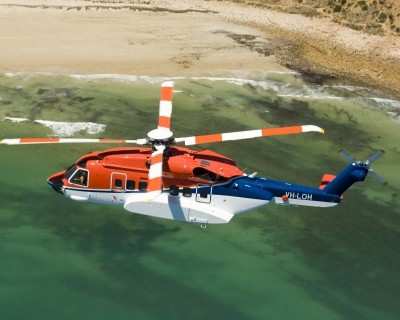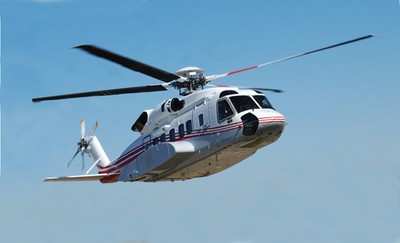New All-Weather Software Also Certified To Enhance SAR
Capabilities
Sikorsky said Monday that the FAA has approved the expansion of
the S-92A helicopter’s operating envelope to execute Category
A vertical takeoffs and landings from ground-level helipads. To
receive this certification, a helicopter must, among other
requirements, be able to continue operating safely in the event of
a single engine failure, either by landing or continuing to fly to
safety from the helipad. The certification process is intended to
increase safety particularly in densely populated areas with
ground-level helipads such as metropolitan hospitals. The S-92A
helicopters’ certified performance capabilities also include
Category A and B airfield take-off and landing, and Class D
certification for carrying occupants externally such as by rescue
hoist.

Sikorsky S-92 File Image
“During the past 12 months, we have added more than 20
enhancements to the S-92 helicopter and increased its capabilities
significantly. This is a robust, proven and rugged aircraft that we
are committed to continually improving,” said Carey Bond,
president of Sikorsky Global Helicopters.
S-92 helicopters perform search and rescue and a variety of
transportation missions for VIPs including Heads of State, offshore
oil and gas crews, and utility and airline passengers. The fleet of
132 S-92 helicopters has accumulated more than 295,000 flight hours
since deliveries began in 2004.

The FAA also approved an advanced and highly integrated,
all-weather operating system that enhances the S-92
helicopter’s already proven search and rescue (SAR)
capabilities. The approval follows previous certification of the
system in 2007 by the European Aviation Safety Agency, which is the
regulatory agency for the European Union, and now allows S-92 SAR
operators in the U.S. to use the technology as well. Also, since
Transport Canada generally accepts FAA policy, approval for use by
S-92 SAR operators in Canada is expected to follow.
The Search and Rescue Automatic Flight Control System (SAR AFCS)
integrates weather radar, thermal imaging and search sensors to
provide the ability for a search and rescue crew to fly to a
geographic waypoint, engage the automatic hover feature, and focus
on bringing survivors safely onboard using the aircraft’s
rescue hoist. The system enables automatic search patterns, lock-on
capability once the target is located, and steady hover control for
the rescue – all functions that greatly reduce crew workload
and increase the likelihood of successful rescues in challenging
weather conditions.

“The S-92 helicopter has distinguished itself as the
premier search and rescue aircraft while operating the past several
years for the U.K. Maritime Coastguard Agency,” said Carey
Bond, president of Sikorsky Global Helicopters. “This system
increases the margin of safety and success in performing the more
difficult rescues that are complicated by tempestuous weather.
Sikorsky has a long legacy of providing life-saving rotorcraft
technology, and we remain committed to continually doing
so.”
In addition to search and rescue, S-92 helicopters perform a
variety of transportation missions for VIPs including Heads of
State, offshore oil and gas crews, utility and airline passengers.
The worldwide fleet of 132 S-92 helicopters has accumulated more
than 295,000 flight hours since deliveries began in 2004.
 ANN's Daily Aero-Term (04.26.24): DETRESFA (Distress Phrase)
ANN's Daily Aero-Term (04.26.24): DETRESFA (Distress Phrase) ANN's Daily Aero-Linx (04.26.24)
ANN's Daily Aero-Linx (04.26.24) Airborne 04.22.24: Rotor X Worsens, Airport Fees 4 FNB?, USMC Drone Pilot
Airborne 04.22.24: Rotor X Worsens, Airport Fees 4 FNB?, USMC Drone Pilot Airborne 04.24.24: INTEGRAL E, Elixir USA, M700 RVSM
Airborne 04.24.24: INTEGRAL E, Elixir USA, M700 RVSM Airborne-NextGen 04.23.24: UAVOS UVH 170, magni650 Engine, World eVTOL Directory
Airborne-NextGen 04.23.24: UAVOS UVH 170, magni650 Engine, World eVTOL Directory





